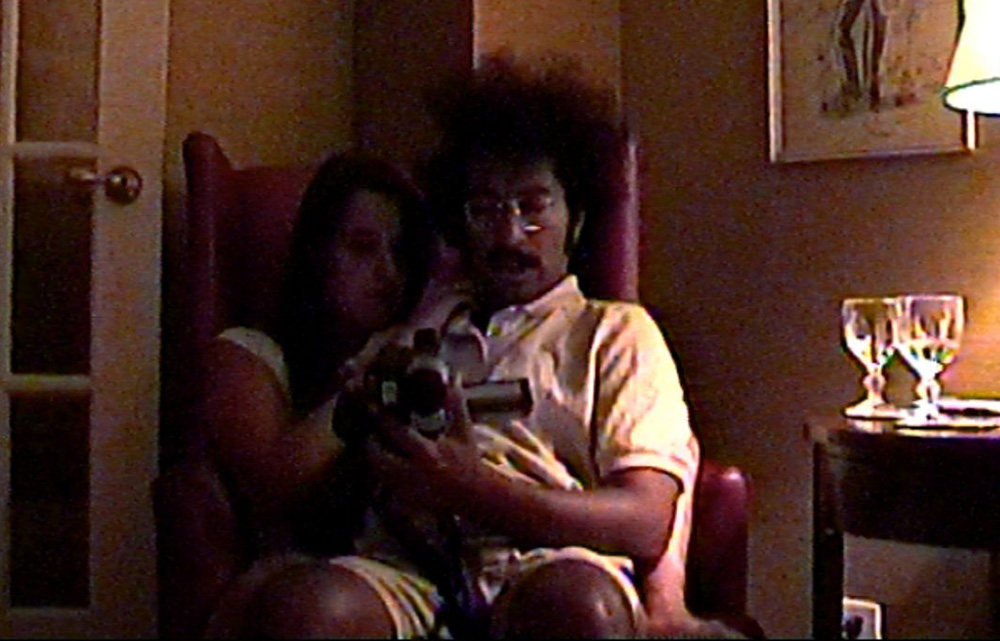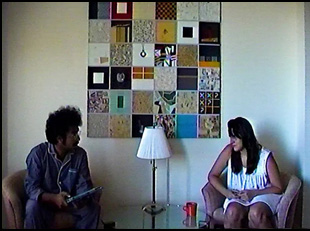The revelations start in “New Strains” as soon as Ram (Prashanth Kamalakanthan) and Kallia (Artemis Shaw) walk through the door of her uncle’s apartment, with the latter surprised that she went unrecognized by someone in the building she can remember flashing her when she was 12. The apartment brings back other memories for Kallia, just as the woman playing her was struck by a wave of things she hadn’t thought about forever upon finding an old camcorder while rummaging around the place she shares with her partner Kamalakanthan during the pandemic, playing back old videos of herself as a teenager where signs of the filmmaker she would eventually become could first be seen, complete with experiments with After Effects.
Those videos end up making cameos in “New Strains,” which may appear at a passing glance to be no more sophisticated than the films Shaw made when she was 13 since she and Kamalakanthan decide to use the exact same consumer-grade camera that she did for their wickedly funny quarantine comedy and have (nearly) no other cast besides themselves. However, the two were each on the verge of a breakthrough with solo projects had it not been for the pandemic — with Kamalakanthan finishing his first feature “Have a Nice Life” and Shaw directing the Sarah Steele-starring short “Real Talk” that nonetheless took off on the festival circuit — and “New Strains” only confirms them to be filmmakers of the highest order, taking the limited amount of resources available and making a meal out of it. However, their skills and synchronicity are limited to only one side of the camera when in front of it, they play a bickering pair that doesn’t handle lockdown well, with Kailla annoyed that Ram has taken up an online challenge from Ice Cube to write a daily rap song and Ram unnerved by finding a photo of his girlfriend with her ex still sitting on her uncle’s bookshelf.
The early digital era frisson of the images becomes an ideal expression for the kind of pent-up frustrations that starts to bubble up between the couple as cabin fever sets in and they resort to making spaghetti with A1 Sauce and pepper, yet while claustrophobia clearly weighs on them, “New Strains” is light on its feet as it observes how they are able to needle each other so specifically having such a close connection and yet feel alien to one another when neither feels like they’re allowed to leave the premises. It takes a lot to want to return to a time that no one wants to remember, but Kamalakanthan and Shaw make the trip worth it when they show such cinematic savvy in maximizing the lo-fi aesthetic with expert edits, mischievous zooms and a charming digital age score and turn a unique historical moment into a sharp, amusing study of a relationship that could exist at any point in time, becoming a discovery every bit as exciting as Shaw uncovering her old home movies. After making its premiere earlier this year at Rotterdam and a recent theatrical run on the coasts, “New Strains” is now available to watch anywhere on digital and recently, Kamalakanthan and Shaw spoke about how being holed up got their creative juices flowing, having to simplify their approach after scaling up with each project so far and not only making a film but creating a process as they went.
Artemis Shaw: The idea first came in winter 2020 when the Diamond Princess luxury cruise ship was quarantined, and it was the first noted U.S. case [of COVID], and I became really obsessed with the Twitters of some of the people quarantined on the boat, especially this one guy who tweeted pictures of all of his quarantine meals. I really liked thinking about what his wife, who was quarantined in the cabin with him, would think of all of this, being on a luxury cruise ship, but in this tiny cabin being served very sad food, so I started thinking about an idea for a play about a couple that should probably break up in quarantine in a setting that’s supposed to be luxurious. Then of course, lockdown hit New York and we stumbled upon this camera and Prashanth said, “Well, why don’t we take that thing you’re working on and adapt it to a film and put ourselves in it?” We’re both filmmakers and we don’t normally act, but we could try. I was a little hesitant at first, but then once we agreed that maybe acting could be fun, we could actually do something pretty creatively interesting and maybe keep ourselves from going too crazy while on lockdown.
This isn’t to dismiss the quality of the film you’ve made, but it’s interesting to me that after the experiences you’ve both had as filmmakers, this seemed to be like becoming Michelin-starred chefs who were in charge of your own kitchens being called upon to make simpler dishes well by yourselves – like the skill is there, but the personnel of a production that you’ve trained to work with isn’t. Is that an adjustment?
Prashanth Kamalakanthan: Yeah, the chef metaphor is interesting. I’ve been watching this guy who does cooking videos and his whole thing is like, “You’re a better chef than you think you are. Forget recipes — all you’ve got to have is salt, fat, acid, heat, crunch, and you can freestyle in the kitchen once you know this,” right? So in 2020, we were graduating from film school and we had essentially learned how to cook [for] fine dining, the standard industrial practices, and then all of the supply chains and the industry at large was shut down, so we were forced to improvise with very little means and only each other. And even well into shooting, we were still wondering, “Is this possible to do? We were never taught in film school that you could do it this way — you always at least need a skeleton crew, even on a so-called micro-budget film, so we really had to figure out scene by scene what the approach would be to build a film with just two people, both in front of and behind the camera. But having all that training and then being forced to work within these constraints, that was a necessary step along the way.
Artemis Shaw: And what was a big learning moment in the process is realizing that there were actually benefits to being a really teeny tiny project. In film school, we were taught how to have a 20-person production, but at absolute minimum, you needed a sound mixer and a DP and a director behind the camera. And it was interesting because we were acting. We were both grateful to not have any crew because we were both acting for the first time and I think our performances actually really benefited from not having anyone around, so it really impressed upon us that for some productions and some stories and some types of performances, smaller is not necessarily a bad thing. It can be a blessing.
Prashanth Kamalakanthan: Yeah, we always say in Q & As that even if there was our one trusted confidant collaborator behind the camera, that would have changed the energy and the performances entirely in some of these scenes. And even with the most skill-trained actors, that’s something really interesting to keep in mind as we scale up and tell different kinds of stories is being very sensitive to setting up a film production the way you want to tell your story.
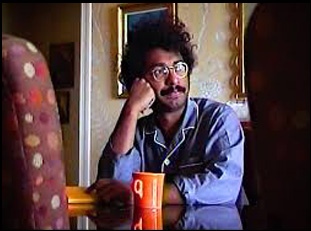
Prashanth Kamalakanthan: Yeah, it starts with finding the actual camcorder that was Artemis’ home movie camcorder, which also coincidentally happened to be the same exact model that my family used. Except in Artemis’s case, the tapes were filled with her first movies, [which were] adventurous around the edges with experimental techniques [in terms of] operating and editing…
Artemis Shaw: And acting…
Prashanth Kamalakanthan: Yeah, just the stuff you do goofing around with a camera when you’re a kid. It just felt so perfect to try and find that language formally to tell the story about a time in which I think we all felt like we reverted to a more primal, childlike state. But there’s just a number of things about that technology that are amazing. As a visual storyteller, I’m always trying to find something away from the digital Alexa monoculture that you see spreading across like platforms, just delving deep into the particularities of this one particular way of seeing, and the most exciting [part] for me as an operator was the 240x Zoom, which we use throughout to create a kind of hypnosis, but also to leave the apartment and to enter into other apartments [across the way] and to enter the park across the street.
Artemis Shaw: Or deep into the paintings.
Prashanth Kamalakanthan: All of that was part of the discovery of making this and the kind of the constant experimentation and recalibration.
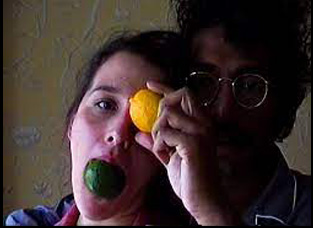
Prashanth Kamalakanthan: That was found.
Artemis Shaw: Not much. [laughs] That was the apartment we were very lucky to have access to for about a month-and-a-half during COVID and once we had this fancy apartment with these wild paintings, we said we needed to take advantage of what was already there.
Prashanth Kamalakanthan: And all of the meditation on the production design and the unearthing eerie aspects of it through the slow zoom was discovered by us while losing our minds in first quarantine. Being within those four walls, there was nothing else to do except stare at the walls and then the walls start breathing sometimes. They show you things that are just hidden under the surface, so it also becomes a visual metaphor for what happens when you’re isolated with somebody. You start to look deeper.
Artemis Shaw: At first glance, you see a painting of a ship in a storm, and you think, “Oh, it’s nice.” Then I think during quarantine, especially with that [intense] zoom, we started looking more carefully and it was one tragic disaster image after another. In every painting, suddenly there was like a man fighting for his life or lonely in the crowd. There were all these tragic figures hidden inside all these paintings and frozen in time.
When you had a month-and-a-half of access to this space and it’s just the two of you, could you just think of a scene and go and shoot it?
Prashanth Kamalakanthan: The luxury that we had shooting this was there were a lot of corners we had to cut, but we had time to maximize them. We had no money and no collaborators that we could like safely call upon. Even the few scenes with supporting actors, we had to choreograph really intricately — the scene with Henry, the ex-boyfriend character in the park, that was his first time seeing anybody in person since the outbreak of the pandemic and we put the lav mics in a Ziploc bag, walked away from the bench, and instructed him from afar how to [prep] himself. We felt like no one knew that we were making this film, so we could take it as slow as the story and us as characters demanded.
Sometimes we would just shoot two or three scenes a day. We worked off an outline that was very detailed and specific, so we knew exactly what the scene order was and what were the important beats and turning points, but the part that we spent a lot of time figuring out was specific actions and lines and moments within these scenes. And like my character, I come from making music and for some reason in that art form, this is the default mode of production. You sit around and you noodle and sometimes songs come out, sometimes they don’t, and if you haven’t raised any money and you haven’t gotten 30 people assembled and taken time out of their schedules, then you can give yourself more flexibility in the time to actually experiment and discover. For certain kinds of films, that can be a really gratifying approach as well.
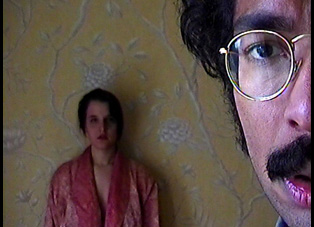
Prashanth Kamalakanthan: I’m sorry to shatter your hopes, but that’s some of the most autobiographical material. [laughs] Yeah, I’ll say no more. People are really good at the internet and search engines, but I definitely have retired from the rap game in order to focus upon taking over the film business.
In general, what was it like to put music on this? It’s a really lively element for the film.
Artemis Shaw: Will [Epstein] was the first collaborator we brought into the film and I think he might have been the first person to see any kind of cut of the film. We knew that we wanted to work with him almost immediately because we liked his work a lot as a songwriter and he was incredibly game. What we all agreed on was that we wanted the music’s voice to be as strong and as unified as the film’s tone and we wanted it to be incredibly present. We didn’t want it to underscore scenes, we wanted it to take over and really seep into the audience’s ear and consciousness.
Will is a huge Hitchcock fan and we all agreed there should be a theme in the film that’s super present and we spent a lot of time developing what we call the “viral” theme in the movie, which is what you hear over and over again, but explored in different ways of the film. I also wanted the sound to reflect in some way the handmade feeling of the film. These early consumer video cameras feel very nostalgic for people our age, and they’re at this intersection of digital and analog, so he tried to do something similar with the music. He used a lot of analog transfer technologies, but then things like toy instruments that you might’ve noodled around within the ’90s, like a Casio keyboard, and other instruments that were at this intersection of what a professional might use and a kid.
Prashanth Kamalakanthan: It also was important for us to get the film’s music stuck in your head. There are all these things that classic Hollywood movies did that and we were interested to bring that into the indie film world, having something like the “Harry Potter” theme, [which] to this day, I whistle while reading them and I thought wouldn’t be cool if we had something like that. Will was totally on board and our soundtrack is now streaming.
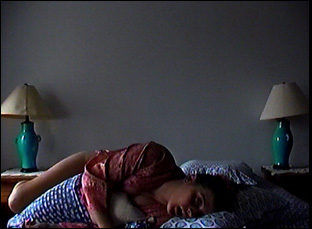
Artemis Shaw: Yeah, so often, once something becomes a professional pursuit, people lament the fact that the childlike joy has gone away, and it was very special to have the luxury to make this during a very chaotic and horrible time in our lives. I’ve noticed artists, especially filmmakers, seem to really appreciate the film because it maybe serves as a reminder that you don’t you don’t need to have an enormous crew and movie stars to express yourself. It sounds very trite, but it was a good opportunity to do something that felt like a snapshot of a specific moment in time.
Prashanth Kamalakanthan: Yeah, we have a kid now and something that’s really reaffirming about that experience is that it reminds you what it was like to be a kid. There’s a lot of chaotic, dismaying, destabilizing things happening not just in the film industry but in the world, and it’s really important to connect back to the simple pleasure of why you’re doing things and why you carry on. Because of how expensive and complicated logistically filmmaking is specifically, [you’re] vulnerable to despair and not being able to do it and hopefully what this film shows is that it’s a lot more accessible than you might think.
“New Strains” will be available to stream on July 19th.




